
Dioscorea alata, also known as purple yam, ube, or greater yam, among many other names, is a species of yam. The tubers are usually a vivid violet-purple to bright lavender in color, but some range in color from cream to plain white. It is sometimes confused with taro and the Okinawa sweet potato beniimo (紅芋), however D. alata is also grown in Okinawa. With its origins in the Asian tropics, D. alata has been known to humans since ancient times.

Dioscorea is a genus of over 600 species of flowering plants in the family Dioscoreaceae, native throughout the tropical and warm temperate regions of the world. The vast majority of the species are tropical, with only a few species extending into temperate climates. It was named by the monk Charles Plumier after the ancient Greek physician and botanist Dioscorides.

Yam is the common name for some plant species in the genus Dioscorea that form edible tubers. The tubers of some other species in the genus, such as D. communis, are toxic. Yams are perennial herbaceous vines cultivated for the consumption of their starchy tubers in many temperate and tropical regions, especially in West Africa, South America and the Caribbean, Asia, and Oceania. The tubers themselves, also called "yams", come in a variety of forms owing to numerous cultivars and related species.
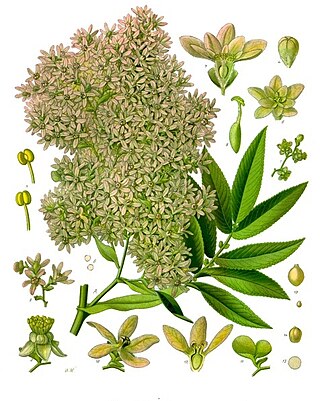
Hagenia is a monotypic genus of flowering plant with the sole species Hagenia abyssinica, native to the high-elevation Afromontane regions of central and eastern Africa. It also has a disjunct distribution in the high mountains of East Africa from Sudan and Ethiopia in the north, through Kenya, Uganda, Rwanda, Burundi, Democratic Republic of Congo, and Tanzania, to Malawi and Zambia in the south. A member of the rose family, its closest relative is the Afromontane genus Leucosidea.

Dioscorea bulbifera is a species of true yam in the yam family, Dioscoreaceae. It is native to Africa, Asia and northern Australia. It is widely cultivated and has become naturalized in many regions.
The Ghana mole-rat or Togo mole-rat is a species of rodent in the family Bathyergidae. It is endemic to Ghana.
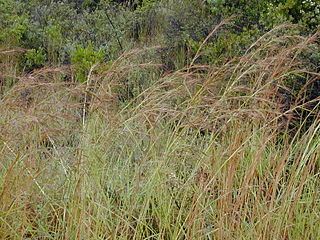
Hyparrhenia is a genus of grasses. Many species are known commonly as thatching grass.
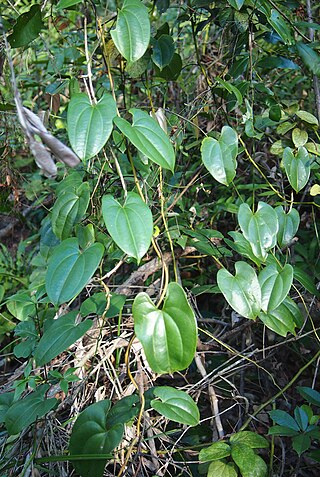
Dioscorea transversa, the pencil yam, is a vine of eastern and northern Australia.

Oxytenanthera is a genus of African bamboo. Bamboos are members of the grass family Poaceae.
Exotheca is a monotypic genus of African and Southeast Asian plants in the grass family.

Dioscorea cayenensis subsp. rotundata, commonly known as the white yam, West African yam, Guinea yam, or white ñame, is a subspecies of yam native to Africa. It is one of the most important cultivated yams. Kokoro is one of its most important cultivars.

Nigeria is by far the world’s largest producer of yams, accounting for over 70–76 percent of the world production. According to the Food and Agriculture Organization report, in 1985, Nigeria produced 18.3 million tonnes of yam from 1.5 million hectares, representing 73.8 percent of total yam production in Africa. According to 2008 figures, yam production in Nigeria has nearly doubled since 1985, with Nigeria producing 35.017 million metric tonnes with value equivalent of US$5.654 billion. In perspective, the world's second and third largest producers of yams, Côte d'Ivoire and Ghana, only produced 6.9 and 4.8 million tonnes of yams in 2008 respectively. According to the International Institute of Tropical Agriculture, Nigeria accounted for about 70 percent of the world production amounting to 17 million tonnes from land area 2,837,000 hectares under yam cultivation.

Dioscorea pentaphylla is a species of flowering plant in the yam family known by the common name fiveleaf yam. It is native to southern and eastern Asia as well as New Guinea and northern Australia. It is widely cultivated as a food crop and naturalized in Cuba and on several island chains in the Pacific.

Dioscorea sansibarensis is a species of flowering plant in the yam family known by the common name Zanzibar yam. It is native to Madagascar and to tropical Africa from Tanzania west to Guinea and south to Mozambique, and it is known elsewhere as an introduced species.
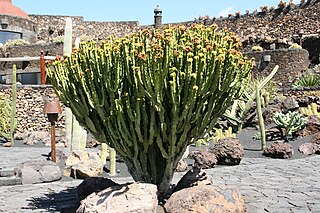
Euphorbia abyssinica, commonly known as the desert candle or candelabra spurge, is a species of plant in the family Euphorbiaceae. E. abyssinica is endemic to Ethiopia, Somalia, Sudan and Eritrea. It was first described in 1791, by the German botanist Johann Friedrich Gmelin. In its native habitat, it can grow up to 10 m (33 ft) tall. The woody stem is used for firewood and as timber in roofing, furniture and other items, and the sap is used in traditional medicine. It is also cultivated as an ornamental house plant.
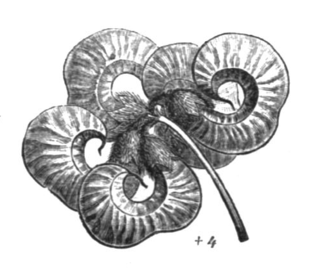
Dorycnopsis is a genus of flowering plants in the legume family Fabaceae. It belongs to the subfamily Faboideae. It includes two species of subshrubs, one native to southwestern Europe and Morocco, and the other native to the Horn of Africa and Yemen.
Astropanax abyssinicus is a flowering plant in the family Araliaceae. It grows in tropical Africa, from southeastern Nigeria to Ethiopia and Zambia.
Lefebvrea is a genus of flowering plants belonging to the family Apiaceae.
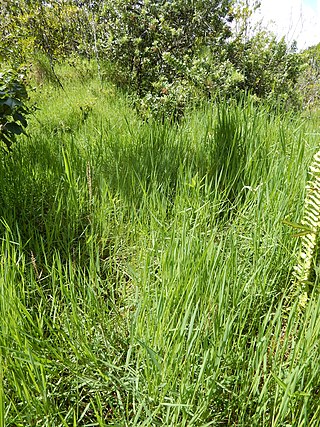
Digitaria abyssinica, the East African couchgrass, is a species of flowering plant in the family Poaceae. It is native to Sub‑Saharan Africa, Madagascar, many of the Indian Ocean islands, the Arabian Peninsula, Sri Lanka, Peninsular Malaysia, Vietnam, New Guinea, and Queensland in Australia, and it has been introduced to scattered locations in Central America and northern South America, and to Saint Helena. Although it is a livestock forage, albeit a low‑quality one, it is generally considered a noxious weed.
Dioscorea floribunda, the medicinal yam or mule's-hoof, is a species of flowering plant in the family Dioscoreaceae. It is found from central Mexico to northern Central America. It is grown commercially for its diosgenin content.














